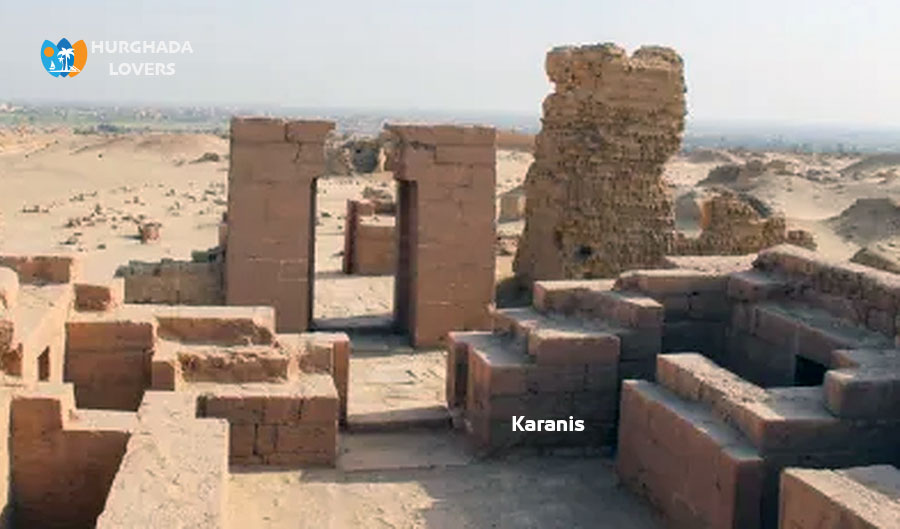Karanis in Fayoum, Egypt | Facts Archaeological Site from Greco Roman era, History of The Lord`s Town in Kom Aushim, The Temples Of Karanis, Map, Entrance Fees, opening hours and more.
The history of Karanis and the facts of the most important Pharaonic archaeological sites, the era of the Ptolemaic Kingdom, the Greco-Roman era, the most important temples and monuments that were discovered, what are the working hours, the price of the entrance ticket and more.
Karanis is a part of that scheme for the settlement operations of all those mercenaries who used to dwell in the city of Greece and then came among the Egyptians in order to exploit that basin of the city of Fayoum, which is the potential fertile.
It was also one of the most important of those cities created at that time in the Arsinoe region and that was going under the leadership of King Ptolemy II of Philadelphia.
Hurghada lovers Offer Luxury Hurghada to Pyramids Tours | El Gouna to Pyramids Tours | Makadi bay to Pyramids Tours | Sahl Hasheesh to Pyramids Tours | Soma bay to Pyramids Tours .
Karanis
Southern Temple in Kranis
● In fact, the archaeological origins of that oldest temple go back to this southern temple, which may go back to the early ages in the first century BC only.
● This is of course from the point of view of the northern point in the north-eastern region, and Augustus in Egypt, as well as those early agricultural libraries in the city of Fayoum.
● They had been sent to clean all the canals and then repair all those dams that had flowed, in order to succeed in restoring the area.
● But after that, that ancient temple was built in the Roman style, which was located on a number of foundations of the ancient temple that existed in the early first century AD.
● But during the rebuilding period, it was tomorrow that the northern temple, which was the smallest, built in the Egyptian style, was also built.
The conditions of the town in the Fayoum area with the karanis
● The settlement operations of the cities in Fayoum, of course, were carried out by all these ancient Roman warriors, after Augustus’ invasion of Egypt.
● This is despite the fact that all those Latin papyri that were found in Cranes were few in number (only two), and the great and enormous number of those Greek papyri of all these ancient warriors or those related to them from that period indicates the existence of all Those soldiers who had come grandfather, who might not actually have any Roman cultural knowledge.
● Augustus had brought both peace and political stability to the country, but his successors survived that prosperity for a number of generations later and were landowners and that happened until the second century.
Papyri in the Karanis region
● In fact, all those telegrams that had been excavated before were actually from that ancient period between that period called Diocletian.
● These telegrams were of great importance or of great historical importance, because they were telegrams belonging to the same place and the same time, and they all dated back to the seventies.
● It was also the case that those documents and collecting artifacts that had been excavated before indicate that the Karanis area was once a relatively poor city.
● “All the excavations that took place at that time could provide evidence of the existence of that life that they were living before, and they were ordinary people in ancient times in Egypt.
● That was under the presence of Greek and Roman rule.” It also provided scientific and practical evidence of a strong relationship between Egypt and the Empire of Rome.
● Archaeologists have also determined that the Carnese and the people who are veterans had no contact with any of the other cities in that area. They were mostly a number of farmers as they were then self-sufficient.
● That is its shadow based on finding those papyri, which mostly contain a number of tax records.
Excavations in that area
These excavations were initially very worrisome, as in the past, to say the least, the farmers were already obtaining a number of permits for the removal of the soil from Tal Karanis.
And they were doing this to use it later as compost (or as manure), and this made that soil rich in organic decomposition materials, and that happened only in the late nineteenth century AD and early twentieth century.
What is the price of a ticket to visit Karanis for the Egyptians?
● Kranis adult visit ticket fee: 10.
● The entrance fee for Egyptian students is only 5 EGP.
What is the price of a ticket to visit Kranis for foreigners?
● The fees for a Kranis visit ticket are 60 Egyptian pounds.
● In the event that the student is a foreigner, the entrance fee is only 30 pounds.
